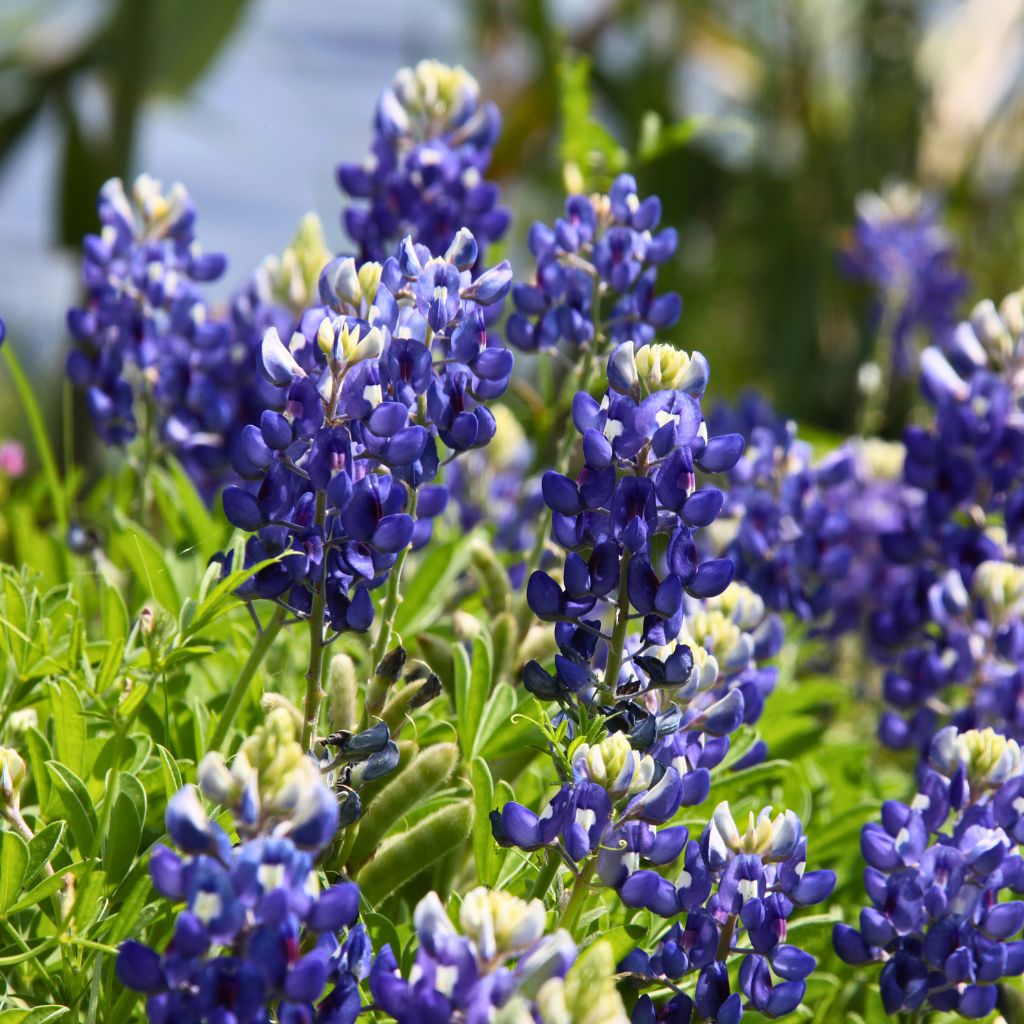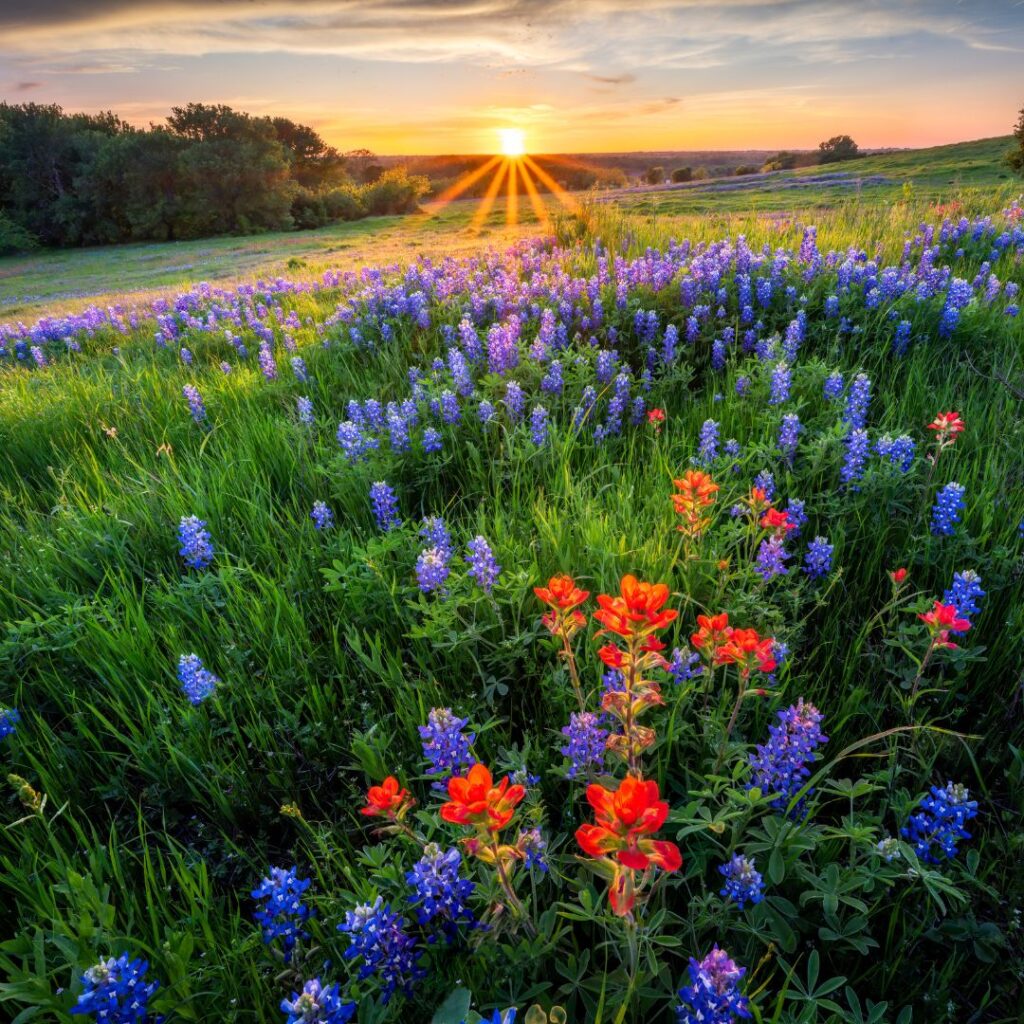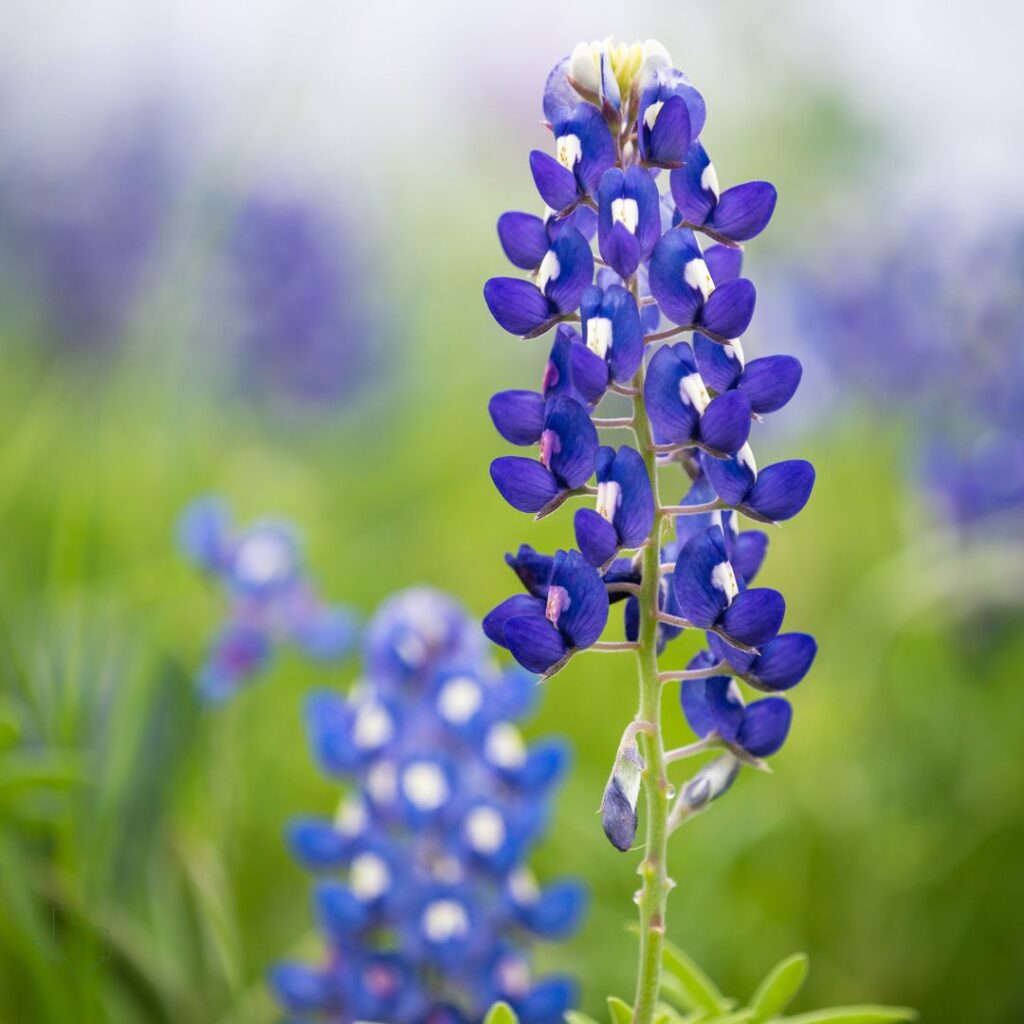Looking for places to find the best, most blue bluebonnets in DFW?
As the Texas state flower, these beauties transform fields and roadsides into picture-perfect Texas landscapes. If you’re searching for the best spots to see them in Dallas-Fort Worth, you’re in luck.
Below, you’ll find our favorite places to catch these iconic Texas blooms, with a special spotlight on the town that really knows how to put on a show—Ennis.
The Ultimate Bluebonnet Destination in Texas: Ennis

Just a short drive from Dallas, Ennis is the ultimate bluebonnet destination. It’s the perfect place for a springtime day trip from DFW!
Officially dubbed the Bluebonnet City of Texas by the Texas State Legislature, Ennis boasts over 40 miles of trails winding through fields of blooming bluebonnets.
Before heading out, check the Ennis City website to see if the blooms are at their peak. The timing depends on the weather, but bluebonnets typically reach full power in April. You can also call the Ennis Bluebonnet Hotline at 972-878-4748 for updates.
The trails are open from dawn to dusk throughout April, but if you want the full experience, plan your visit around the Ennis Bluebonnet Trails Festival, happening April 11–13, 2025. Expect live music, food, and plenty of family-friendly entertainment in downtown Ennis.
Exploring the Bluebonnet Trails in Ennis
Head south on Highway 45 toward Corsicana, and about 40 miles later, you’ll start spotting those famous rolling fields of blue.
Once in town, you have a few options for exploring:
- Take a guided bus tour hosted by The Ennis Garden Club (Call the Ennis Visitor Center at 972-878-4748 to reserve.)
- Explore on foot at Bluebonnet Park with a self-guided trail map. You can grab a physical copy when you arrive or download the free Ennis Y’all app before you go.
- Drive the scenic trails if you prefer to stay in the car.
The trails also feature picnic areas and playgrounds, which are marked on the maps.
A quick note for parents:
Strollers aren’t recommended on these trails unless it’s a jogging stroller. Some areas don’t allow strollers at all to help protect the delicate wildflowers.
Even More Bluebonnets in DFW

If you’d rather stay closer to home, you’re in luck! There are plenty of spots bluebonnets in Dallas-Fort Worth to catch a stunning display of blue hues.
Note: Since blooming times can vary, always call ahead to make sure the flowers are in full swing.
Event Centers and Businesses:
Beyond trails, parks, and the side of the road, these are the best places to see bluebonnets in DFW this year:
- Native Texas Park at George W. Bush Presidential Center: This 15-acre urban nature park recreates native Texas landscapes with wildflower meadows, walking trails, and—of course—plenty of bluebonnets. Bring the kids for a self-guided tour anytime during daylight hours, or join a guided tour on Saturday mornings at 10 a.m. from mid-March through May. Contact: 2943 SMU Boulevard, Dallas |214-200-4300
- Myers Park & Event Center: Park at the Collin County Farm Museum and walk toward the pond for a hillside view of bluebonnets in full bloom. Contact: 7171 County Road 166, McKinney | 972-548-4792
- The Gardens at Texas A&M University: If you’re making a road trip south, don’t miss A&M’s famous maroon bluebonnets (also called maroonbonnets or Alamo Fire)! These rare crimson and pink varieties bloom through early-to-mid April. Texas Maroon bluebonnets are a special variation developed in collaboration with Douglass King Seeds and Dr. Jerry M. Parsons. The original plant was discovered near La Pryor, Texas, and it has taken over 30 years to develop this stunning hue. Don’t miss A&M’s Hullabloom Festival on April 26, 2025, which features garden activities, crafts, and butterfly releases. Contact: 556 John Kimbrough Boulevard, College Station | 979-314-2357
- Freedom Meadow: Don’t miss this 9/11 memorial site at the Warren Sports Complex! Freedom Meadow is blanketed in Texas bluebonnets each spring, thanks to the efforts of the Frisco Garden Club. Contact: 7599 Eldorado Parkway, Frisco | 972-292-6500
Trails and Parks:
These are the best trails and park spots to see bluebonnets in DFW this year:
- Arbor Hills Nature Preserve: The Preserve is one of the most beautiful places to see bluebonnets in DFW! Take a springtime stroll with scattered bluebonnet patches throughout the preserve. Contact: 6701 W. Parker Road, Plano | 972-941-7250
- Cedar Hill State Park: At DFW Family Directory, we just love Cedar Hill State Park! Find blooms near the campsites and along the park roads, especially around the Penn Farm Agricultural History Center. Contact: 1570 FM1382, Cedar Hill | 972-291-3900
- Campion Trail: Head to the north end near Sam Houston Trail Park or south toward T.W. Richardson Park to spot beautiful Texas bluebonnets. Contact: Riverside Drive & Spur 348 Irving, TX 75063 | 972-721-2501
- Coppell Nature Park: Coppell’s 66-acre Nature Park is a gem of a place to hike, walk, or hit the playground. To see bluebonnets, look for a small wildflower area near the parking lot. Contact: 367 Freeport Pkwy, Coppell | 972-304-3581
- Bluebonnet Trail Greenbelt: If you’re out for a walk on Bluebonnet Trail Greenbelt, keep an eye out for bluebonnet patches along the 8.3-mile trail. Address: Spring Creek Parkway and Custer Road, Plano
- Russell Creek Park: This Plano park has a nice burst of bluebonnets and tends to be less crowded than others on this list. Address: 3500 McDermott Road, Plano
Frequently Asked Questions

Why are bluebonnets the Texas state flower?
Actually, Texas doesn’t have just one state flower, it has six. They all belong to the Lupinus genus, and they all go by the same name: bluebonnets. Here are the official six:
- Lupinus havardii (Big Bend bluebonnet)
- Lupinus perennis (sundial lupine)
- Lupinus plattensis (Nebraska lupine)
- Lupinus subcarnosus (sandyland bluebonnet)
- Lupinus texensis (Texas bluebonnet)
- Lupinus concinnus (bajada lupine)
In 1901, the Texas Legislature decided it was time to pick a state flower. The cactus was a top contender, but the Colonial Dames of Texas pushed for the bluebonnet, and they won.
On March 7, 1901, the Lupinus subcarnosus became the official state flower. However, over the next 70 years, Texans argued over which bluebonnet to use. In 1971, the Legislature included Lupinus texensis and “any other variety of bluebonnet not heretofore recorded” into the law. So, in short, every bluebonnet in Texas is now the state flower.
Is it illegal to pick bluebonnets in Texas?
Despite what you might have heard, there’s no law against picking bluebonnets in Texas. The Texas Department of Public Safety confirms that you can pick them as long as you’re not trespassing, damaging property, or putting yourself or others in danger. That means no digging up clumps, no parking in wildflower fields, and definitely no stepping into traffic for the perfect photo. Also, keep an eye out for snakes and fire ants, who love bluebonnets as much as we do.
Is it illegal to take pictures with bluebonnets in Texas?
Luckily, there are no laws against snapping pics (professional or otherwise) of the bluebonnets, and it is not illegal to pick them, but always be careful not to damage them.
Are bluebonnets exclusive to Texas?
While we think the bluebonnets in DFW are something special, technically, Lupinus Texensic and Lupinus Subcarnosis are the only species found exclusively in Texas. Bluebonnets can also be found in Oklahoma, Florida, Arkansas, and some Mexican states like Coahuila or Nuevo León.
Know of More Bluebonnet Hotspots in DFW?
Spring is short but sweet in Texas, so grab the family, pack an aesthetic picnic, and get outside to enjoy one of our state’s most breathtaking natural beauty.
If you know of any other bluebonnet hot spots we didn’t list here, please comment below or tag us on social media @DFWCampExpo so that we can add them to our list!
